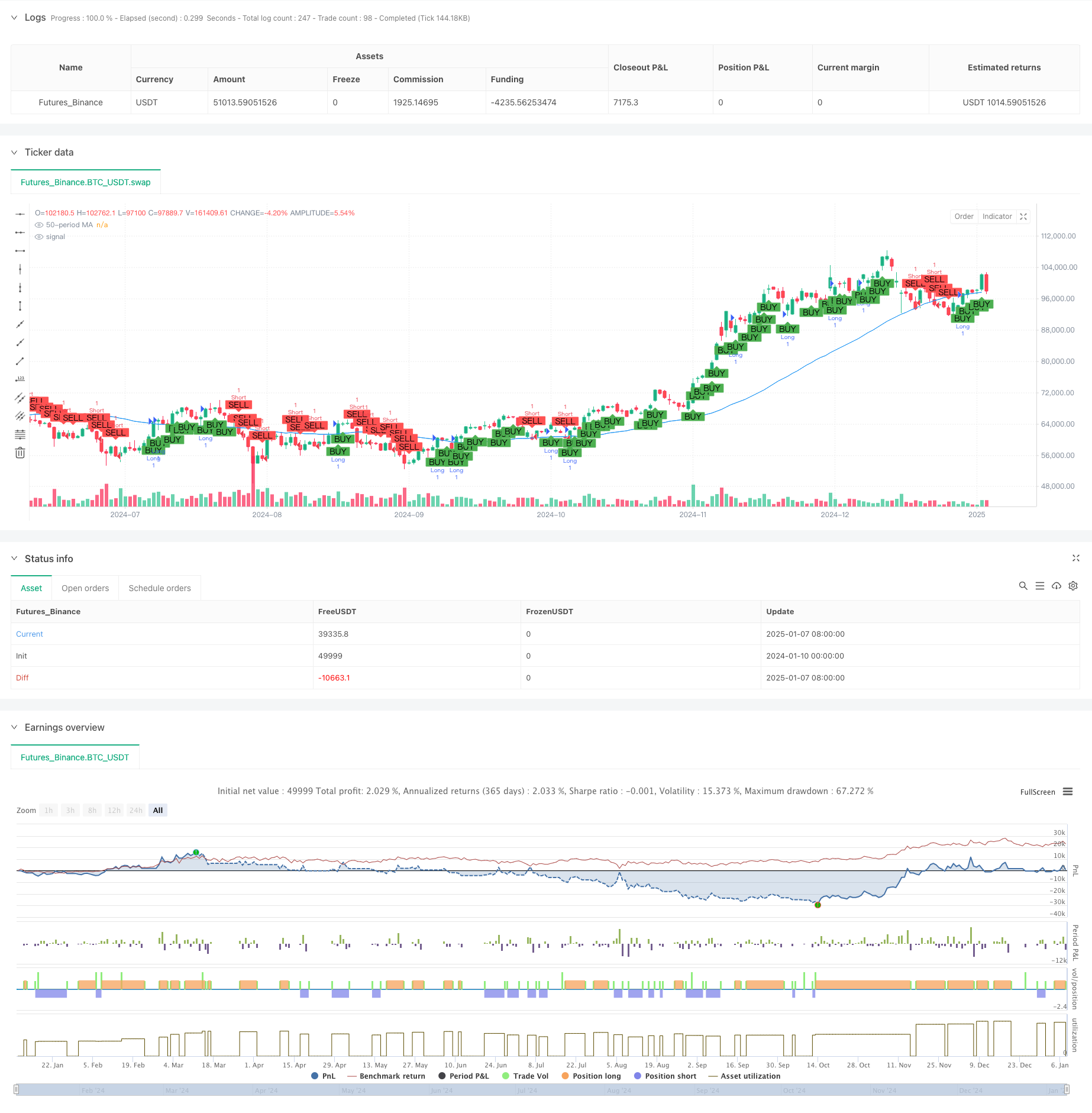
概述
该策略是一个基于5分钟时间框架的自动化交易系统,结合了移动平均线趋势跟踪和成交量分析方法。策略通过50周期简单移动平均线(SMA)来确定市场趋势,同时引入成交量分析来验证交易信号的有效性。系统采用了固定的止损和获利目标,实现了全自动化交易。
策略原理
策略的核心逻辑包括以下几个关键组件: 1. 趋势识别:使用50周期SMA判断市场方向,当收盘价高于均线时判定为上涨趋势,反之为下跌趋势。同时结合近30分钟(6根K线)的价格走势进行趋势确认。 2. 成交量分析:基于价格波动计算买卖成交量,将每根K线内部的成交量按照收盘价位置分配为买入成交量和卖出成交量。 3. 交易信号生成:在上涨趋势中,当买入成交量大于卖出成交量时产生做多信号;在下跌趋势中,当卖出成交量大于买入成交量时产生做空信号。 4. 风险控制:采用3%的止损和29%的获利目标来管理每笔交易的风险收益比。
策略优势
- 多维度趋势确认:通过结合均线和短期价格走势双重确认趋势,提高了趋势判断的准确性。
- 成交量验证:引入成交量分析作为交易信号过滤器,避免在低成交量环境下的虚假突破。
- 风险管理完善:设置了明确的止损和获利目标,有效控制单笔交易风险。
- 自适应性强:策略可以根据市场状态自动调整交易方向,适应不同市场环境。
策略风险
- 震荡市场风险:在横盘震荡市场中可能产生频繁的假突破信号,导致连续止损。
- 滑点风险:在高频交易中,可能面临较大的滑点,影响实际执行效果。
- 参数敏感性:策略效果对均线周期、成交量计算周期等参数较为敏感。
- 市场环境依赖:策略在明确趋势市场表现较好,但在趋势转换期可能出现较大回撤。
策略优化方向
- 动态参数优化:可以引入自适应参数机制,根据市场波动率动态调整均线周期和成交量计算周期。
- 增加市场环境过滤:添加波动率指标或趋势强度指标,在不适合的市场环境下自动停止交易。
- 改进止损机制:可以采用动态止损,如跟踪止损或基于ATR的止损,提高风险控制的灵活性。
- 优化信号生成逻辑:可以考虑加入更多技术指标进行交叉验证,提高信号可靠性。
总结
该策略通过结合趋势跟踪和成交量分析,构建了一个完整的高频交易系统。策略的主要优势在于多维度的信号确认机制和完善的风险控制体系。虽然存在一些固有的风险,但通过提出的优化方向可以进一步提升策略的稳定性和适应性。策略特别适合在具有明确趋势的市场环境中运行,通过合理的参数优化和风险管理,有望实现稳定的交易效果。
策略源码
/*backtest
start: 2024-01-10 00:00:00
end: 2025-01-08 08:00:00
period: 1d
basePeriod: 1d
exchanges: [{"eid":"Futures_Binance","currency":"BTC_USDT","balance":49999}]
*/
// This Pine Script™ code is subject to the terms of the Mozilla Public License 2.0 at https://mozilla.org/MPL/2.0/
// © Jerryorange
//@version=6
//@version=6
strategy("Autonomous 5-Minute Robot", overlay=true, fill_orders_on_standard_ohlc=true)
// --- Inputs ---
maLength = input.int(50, title="Trend MA Length") // Moving average length for trend detection
volumeLength = input.int(10, title="Volume Length") // Length for volume analysis
stopLossPercent = input.float(3, title="Stop Loss (%)") // 3% stop loss
takeProfitPercent = input.float(29, title="Take Profit (%)") // 29% take profit
// --- Market Trend Detection ---
ma = ta.sma(close, maLength) // Simple moving average for trend direction
isBullish = close > ma // Market is bullish if the close is above the moving average
isBearish = close < ma // Market is bearish if the close is below the moving average
// --- Volume Analysis ---
buyVolume = (high != low) ? volume * (close - low) / (high - low) : 0
sellVolume = (high != low) ? volume * (high - close) / (high - low) : 0
totalVolume = volume
// --- Define Market Direction over Last 30 Minutes (6 candles in 5-minute chart) ---
lookback = 6 // 30 minutes / 5 minutes = 6 bars
prevClose = close[lookback] // Previous close 30 minutes ago
currentClose = close // Current close
uptrend = currentClose > prevClose and isBullish // Uptrend condition
downtrend = currentClose < prevClose and isBearish // Downtrend condition
// --- Strategy Logic ---
longCondition = uptrend and buyVolume > sellVolume // Buy signal when trend is up and buy volume exceeds sell volume
shortCondition = downtrend and sellVolume > buyVolume // Sell signal when trend is down and sell volume exceeds buy volume
// --- Entry and Exit Strategy ---
if (longCondition)
strategy.entry("Long", strategy.long)
if (shortCondition)
strategy.entry("Short", strategy.short)
// --- Exit Strategy based on Stop Loss and Take Profit ---
strategy.exit("Exit Long", "Long", stop=close * (1 - stopLossPercent / 100), limit=close * (1 + takeProfitPercent / 100))
strategy.exit("Exit Short", "Short", stop=close * (1 + stopLossPercent / 100), limit=close * (1 - takeProfitPercent / 100))
// --- Plotting for Visualization ---
plot(ma, color=color.blue, title="50-period MA") // Trend line
plotshape(longCondition, style=shape.labelup, location=location.belowbar, color=color.green, text="BUY")
plotshape(shortCondition, style=shape.labeldown, location=location.abovebar, color=color.red, text="SELL")
相关推荐